If you have found this article, chances are you are in a bit of trouble with your semi-inground swimming pool caving in. That’s Ok. Take a breath and read on. I can help.
Semi-inground pools will only cave-in when they don’t have water in them. You should only drain a semi in-ground pool when it’s time to change the liner.
THEY DON’T CALL IT AN ABOVE GROUND POOL FOR NOTHING
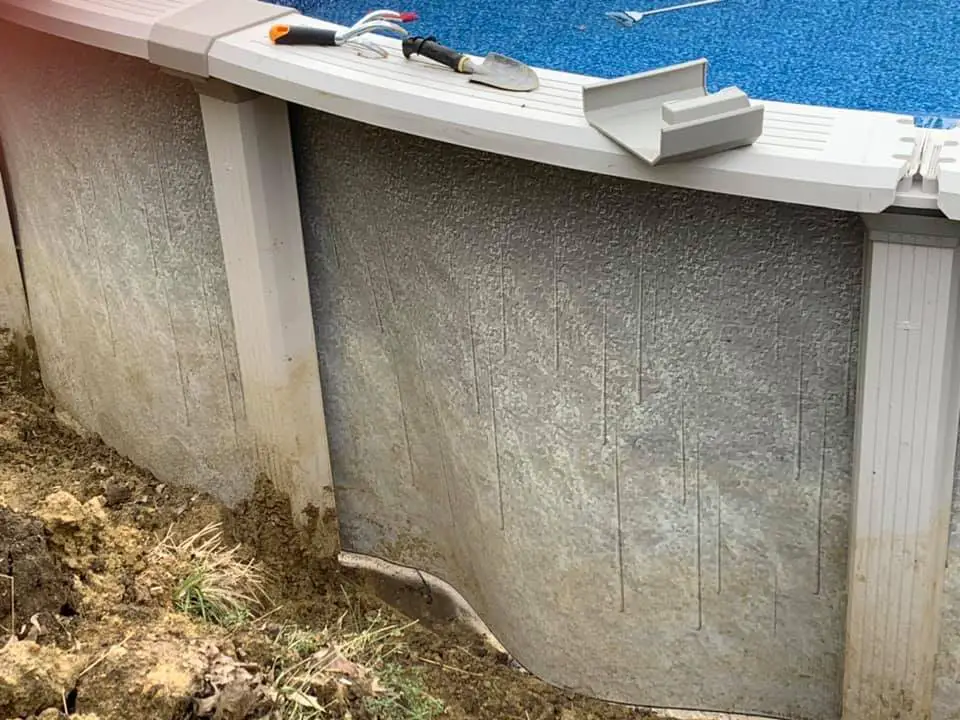
The majority of semi-inground pools are simply above ground pools that have been buried partially in the ground. If your pool is caving in, then it’s most likely one of these.
Above ground swimming pools can be successfully put partially in the ground with no issues. It won’t cause them to rust prematurely, damage it structurally, or take any life away from it. And as long as it’s full of water, the pool can’t move or cave inward (because of the outward pressure of the pool’s water).
When an above ground pool that is partially (or fully) in the ground is emptied, it can start to cave in. This means the earth around the outside of the wall of the pool will start to lean in. The weight of the earth will then start to push the wall inward and start to reclaim that space that was dug out for the pool.
In-ground vinyl liner pools are reinforced with a lot of concrete and true semi-inground pools have much more rigid and thick slatted walls that come in sections. Both of these designs can handle the earth pressing inward when the pool is empty. And both of these cost a ton more money.
So, what I’m saying here is that an above ground pool is not designed to have pressure against the outside of the wall. The wall is just a thin, continuous roll of steel or aluminum which can hold its own as long as it has plenty of outward pressure (like when it’s full of water).
THE FARTHER IN THE GROUND, THE BIGGER THE PROBLEM
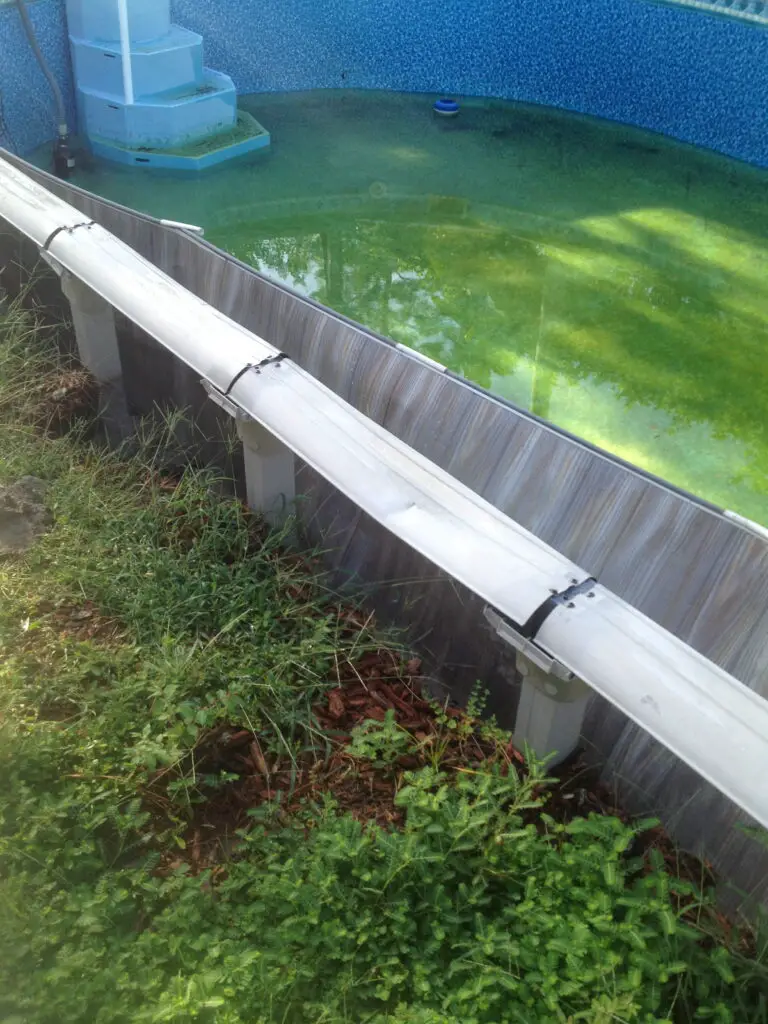
When future pool owners consult me about going in the ground with their pool, my advice is always to only go down a maximum of half-way. This is to help ensure that there won’t be an issue when it’s time to change the pool’s liner (which is the ONLY time the pool should be drained).
So, for an above ground pool that has a wall height of 48”, 52”, or 54”, it should go down between 24” or 30” or less. Any further than that increases the chances of having a cave-in during a future liner change.
As an example of this, last week I had an install where the customer wanted to bury their pool down some. They were choosing between going down one foot or two feet. I advised them that with going down only one foot, they absolutely won’t have a cave-in issue later at liner change time. But if they go down two feet, they had about a 25% chance of a cave-in. This was based on their earth which was very sandy and loose.
If your pool is caving in, the problem will probably be bigger if it’s deeper in the ground. So, if you are more than two feet down, expect a more extreme fix than if you are only 1.5 ft. in the ground.
EXTREMELY OFF LEVEL INSTALLS
Some above ground pools had no choice to being in the ground on one side. They were installed in a yard that is extremely off-grade, so to make the pool level, it had to be dug in and installed on the high side of the yard. With an install like this, the pool may be completely out of the ground on one side, and two or three feet in the ground on the other.
With some yards, it’s unavoidable to have part of the pool in the ground as a pool has to be level no matter what (water can only be perfectly level). Pools in this situation can have cave-ins too, but overall, this is usually not as bad a situation as a pool that is in the ground all the way around.
MY POOL IS CAVING IN. WHAT DO I DO NOW?
When someone calls me and says “My pool is caving in,” I cannot tell how bad their situation is as there is a big difference between a small area toward the bottom of a pool that has been empty for a week and the top of a pool coming in immediately while its draining and the pool is only half empty.
So, regardless of your cave-in situation, here are some steps to first assess and then what to do.
#1 Stop draining the pool
It’s best to keep as much water in the pool as possible when assessing a cave-in. This is because any water still in the pool will help keep things from getting worse.
In most cases, you won’t be able to put water back in the pool as it may have leaked out or the liner has now shrunk from not having water in it and cannot be refilled. If it’ll hold the water when you put some back in, then do so. If you can’t, then you can’t. Don’t worry about it and move forward.
#2 Determine how far the pool is in the ground
By digging out the outside of the pool at an upright or somewhere, you can find the bottom of the pool. Do this so you know how far down in the ground the pool is.
This is important information for fixing the problem. If your pool is only one foot in the ground and caving in, then that’s going to be a much easier fix. If you are 3 feet down though, this will tell you that there may be a big job ahead of you.
#3 See what is around the outside of the pool at the area that the cave-in is occurring
This is important because this area will have to be dug out.
Look to see if there is anything in the way or anything that will make digging the dirt out around the outside of the pool wall more difficult. Most above ground pools have a border of rocks or mulch around the perimeter of it. This makes the digging a little harder. Plants next to the pool may have to be dug up in order to fix the cave-in, so come to terms with that.
Any trees close enough by will have roots in the ground. This will make digging out the pool on the outside tougher. If there are any pavers for a walkway or anything, be prepared to move those if they are close to the pool.
If you have a deck attached to the pool where the cave-in is, then that is a worse case scenario. That means you won’t have any room on the outside of the pool to dig out around it. Yikes!
#4 If the area outside of the pool is open, then dig out around the pool where the cave-in is
To stop and fix where it’s caving in, you must remove the earth from where it’s pushing in the wall.
If the area around the pool is clear, then great. Now get a shovel and start digging out next to the wall of the pool. Depending on how deep the pool is (see step 2) will determine how much dirt has to be dug up. The deeper the pool is in the ground, the farther out you will have to start your hole away from the wall.
Remember that you are doing this to relieve the wall from the dirt pressing inward and against it, so if you start digging too close to the wall, then the digging will make things worse. Start well away from the pool wall and allow the hole you are digging to let the dirt directly next to the pool wall fall away from it. Then you can dig that dirt out.
There are things that will make this dig-out tougher. Digging up decorative rocks or mulch, weed barriers, and roots can wear you out quick. Take your time with this. Expect to make a mess and that this will take up a lot of space.
#5 What if there’s a deck in the way?
This is a worst-case scenario for digging out a cave-in.
Check to see if there is room under the deck to dig out around the wall. This is one of those things that makes it tougher if the pool is farther in the ground. The farther down the pool is in the ground, the less space there is under the deck.
If there is room under the deck, then crawl under there and dig out the wall. Use a short handle shovel for this if you can. It’ll make it a lot easier.
If there’s no room to crawl under the deck, then see what it would take to remove some of the decking boards so you can get to the pool wall underneath. This may be a royal pain, but it’s worth it if it gives you room to dig the pool wall out.
#6 The deck or something permanent is in the way around the outside of the pool. You cannot dig the pool out from the outside. Now what?
When a pool has a concrete deck, an inaccessible wood deck, pavers, or anything that disallows for digging out the outside of the pool’s wall, it’s time to dig out the cave-in from the inside of the pool.
This is not the ideal way to fix a cave-in, but I’ve had to do it this way a hundred times and it’s doable. Here are the steps:
HOW TO FIX A CAVE-IN FROM THE INSIDE OF A SEMI-INGROUND POOL
The absolute only way to fix a pool from a cave-in is to remove the earth that has caved in and prevent any other earth from caving in while the pool is empty and before you can refill it.
This is best done from the outside of the pool, but if that can’t be done, then this is what you do.
#1 Drain the pool and remove the liner
Some pool owners and novice pool guys will try to reuse the existing liner, but anyone who knows what they are doing will replace the liner as part of a fix like this.
I consider a fix like this as a major one. It’s going to be hard enough to do this without worrying about saving an existing liner. Just do yourself a favor and cut out the old liner and buy a brand new replacement.
#2 Take the top of the pool apart above where the cave-in is
You will have to take a much bigger section off of the top of the pool than the size of the cave-in. This will allow you to move the pool’s wall.
#3 As gently as possible, move the wall out of the track and inward
Pull the wall out of its bottom track and inward toward the middle of the pool. Pull in enough of the wall so to have room to dig out the dirt that has caved in.
#4 Get on the outside of the wall and dig out the dirt caving in
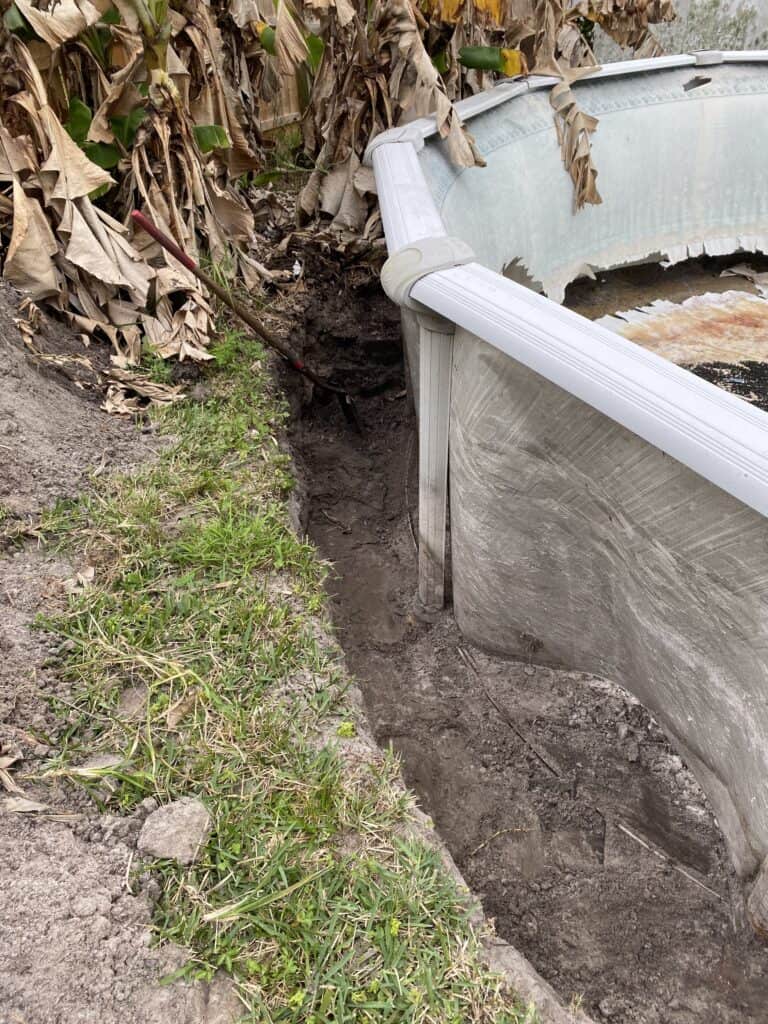
Be careful to keep the bottom track in place and dig out any earth that has caved in along with any other earth that may cave in before you can get water back in the pool.
It’s important to be thorough here. Dig out a lot of the dirt. Dig out more dirt than you think you need to. You absolutely don’t want any dirt to cave back in before you can get the pool back together and the liner put in it.
Pile the dirt anywhere you can around the outside of the pool. It has to be completely out of your way.
#5 When completely dug out, set the wall back in place
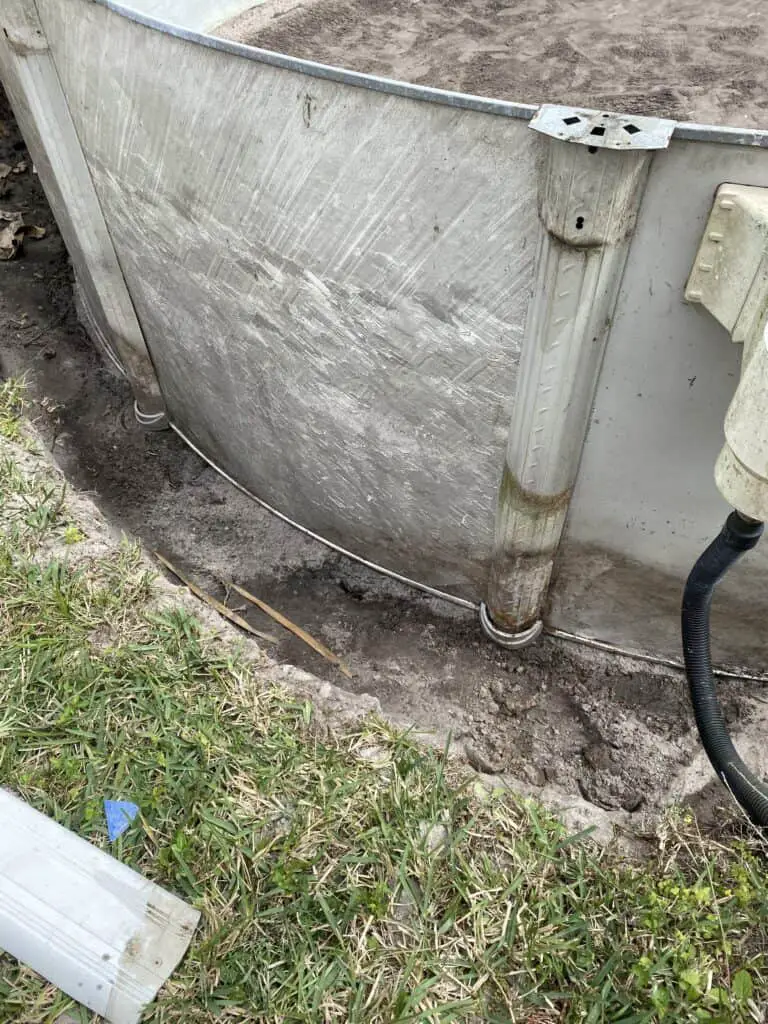
Now that the entire area is clear of any dirt and any dirt that may cave in, you can replace the wall.
Clean out the bottom track of any dirt and re-level any block under an upright that needs it. Replace any upright that you may have removed and then get the wall back in the track.
The wall may not want to go back in the track. It may seem too long or too short and will frustrate you. This happens and doesn’t mean anything is wrong. Move the track in any way you have to in order to get the wall back in place and move on.
It may not be exactly where it was to begin with and that’s fine. Get it in place as good as you can and put the top stabilizer bars on the wall and you should be good.
#6 Replace the coving, re-smooth the pool’s bottom, and get the new liner in
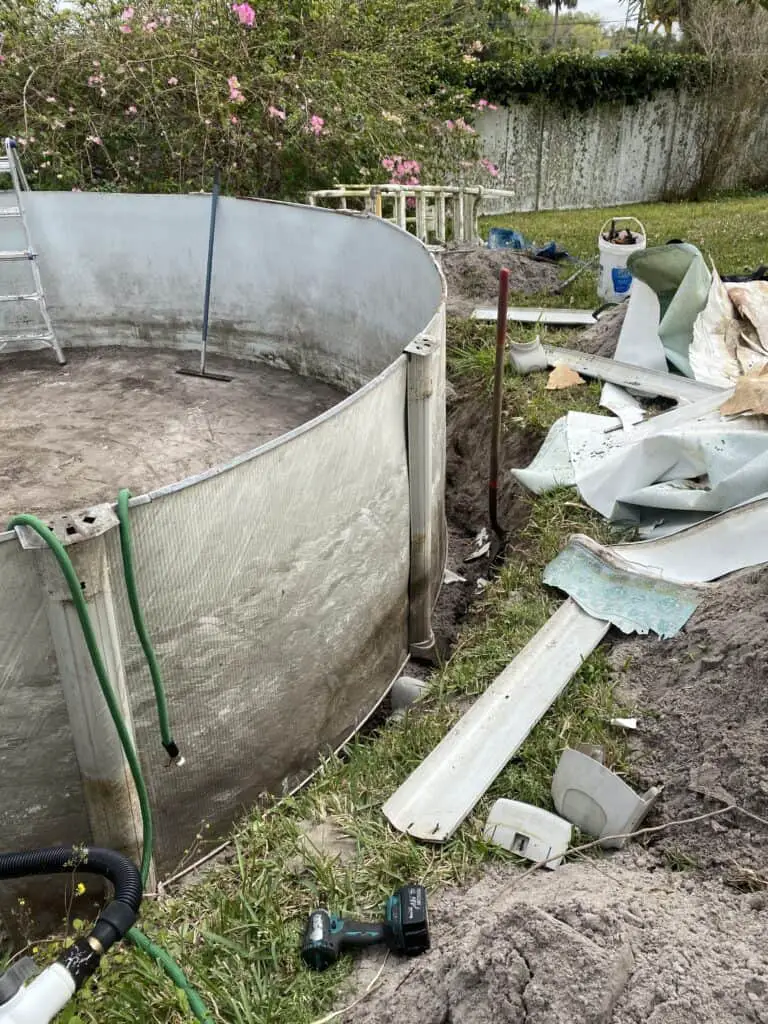
Hopefully, you are done with this, but you’ll need to take the top off of the rest of the pool to get a new liner in. This may reveal another area for a cave-in.
If another cave-in starts, then you know what to do. Do it and don’t risk it caving in after the new liner goes in. It is disastrous to have a cave-in after a new liner is in place. It’s happened to me a few times and this is why I’m all about making sure there will be no caving in during a liner change.
#7 After the liner is in and the pool is full, you can now replace the dirt
– When the pool is full of water again, it’ll have that all-important outward pressure. You can now put back all the earth you had to dig out.
PREVENTING A FUTURE CAVE-IN
If you just went through the above steps and don’t want to have to do it again the next time you drain the pool (during a liner change only), consider doing something to prevent the area/s from caving in again.
Building some type of retaining wall in the bad areas will solve any future problems, but that’s a major and potentially expensive fix. If the situation is extreme and the pool looks like it will be lasting for many years, then do that.
A lesser preventive measure is to simply add some bags of concrete when putting the dirt back in around the pool. As you replace the earth, sprinkle in dry concrete. You don’t have to worry about mixing the concrete first. It will harden in the earth without having to add water.
Adding this concrete will firm up the earth next to the pool’s wall and potentially prevent the earth from caving in next time.
WHAT IF MY POOL IS CAVING IN BUT ISN’T IN THE GROUND AT ALL?
Even though this is an impossibility, I occasionally get a call that a pool’s wall is caving in and it’s completely above the ground. This isn’t a cave-in.
What happens here is that a pool is either filling for the first time or has been emptied and now the wall of the empty pool is dented inward. This usually means that the pool is either severely off level, out of round, of both.
This can be fixed by making the pool level and making sure it’s in its proper shape. To fix this, the pool may be jacked up and leveled in place or re-rounded by removing the coving and kicking it in place. This is a fix done only by someone very experienced as there is a lot that can be done wrong.
If in really bad shape, the pool may have to come down and the bottom track leveled and reshaped.
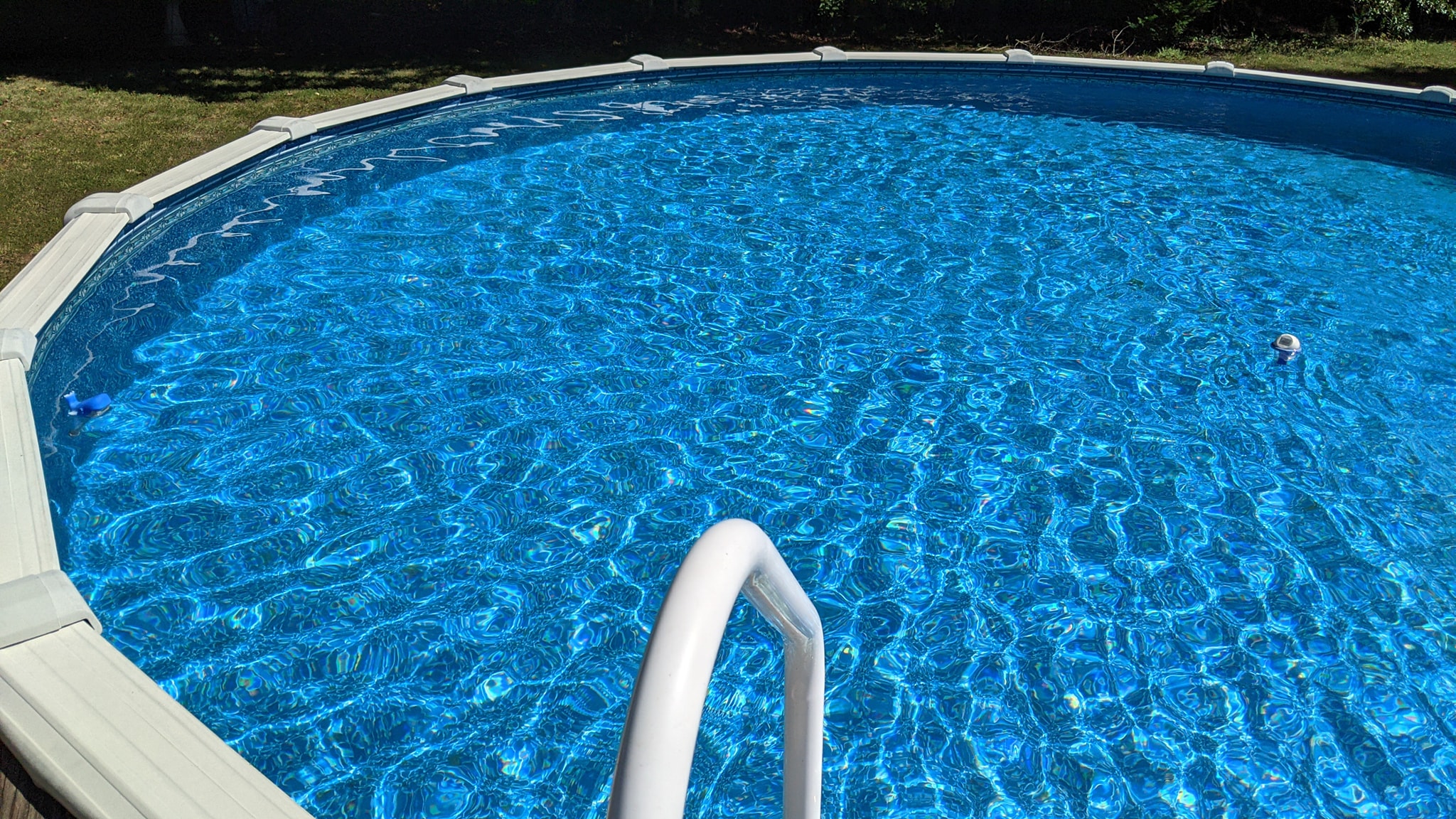
Dear Dan! I have been on my phone for hours looking for hints as what to do with my pool. It is a 15’ round, partially in the ground on the patio side, about 1/4 with a deck about 1/4 surrounding it. This current pool was installed in 2016. The second one on the site. We closed the pool at the end of September. We live in Connecticut and it was a warmer fall than usual. Since we are not pool newbies, we followed all of our normal procedures. By mid November the pool was empty. We tried re-filling it, but it never made a difference. Today, the day after Christmas, we took the cover off and can not find ANY holes or slices in the bottom of the pool. There is just a small amount of water in the center of the pool, not extending to the sides. We have foam
Lining on the inside of the walls and coving around the seams, we also use a ladder mat.
My son with his winter boots and gloves on, tried to inspect everything. The pattern on the liner makes it impossible to tell.
We are going to get a new liner in the spring and put it on top of the current one if it doesn’t shrink too much.
My concern is maintaining this empty pool all winter. We threw about a dozen winter cover pillows in the bottom, and we are putting some PVC pipe supports across the top
Of the walls and have a loose fitting larger cover that we are just clipping on. We can easily keep up with snow and rain using the cover pump. No one we know has had a pool drain completely like it did without seeing a tear. One day in November it was fine and the next week, it was empty! Any ideas? I want to relax and not worry about this all winter, because I would like to keep this 5.5 year old pool so I can just replace the liner next spring!
Hi. If I read you right, you are saying that the pool is only about 1/2 of the way around in the ground. How deep in the ground is it? If more than 2′ deep, then you can be concerned. If you get high winds, then be concerned. I would prop up things like shovels or rakes against the wall that is in the ground to help. It’s good that this is a 15′ round as it has a tighter radius which makes the wall stronger when empty.
If it decides to cave-in some down low, then there’s not much that you can do with the pool being empty. Just dig out what has caved-in from the outside so the wall can go back in place when you change the liner.
And DO NOT keep the old liner in there. It, along with the new liner can trap moisture which can rust/corrode the inside of the wall (wall foam or not).
Hi bought a pool liner from great escape the guy put it in and did an awesome job then when I get 24 inches high the liner gave out it was a bedliner! Now the guy is in jail for a DUI and we have a new liner but no one to put it in in our pool is caving in with Stone on the outside of it
So sorry for your really bad luck. I don’t know what a bedliner is (unless you’re talking trucks), but sounds like a seam separation. Really unfortunate when semi-inground.
Hello. Hoping you can help provide some guidance. We just had an above ground pool installed and it is recessed 48-inches intro the ground with a slurry backfill, which meets the manufacturers warranty. The backfill was just completed three days ago. I noticed today that there is a bulge on one side of the pool. It actually looks like the contractor may have hit the pool wall with his machinery and dented it in. He didn’t tell us. My concern is – will this create a bigger issue down the road when we winterize? It’s closer to the top of the pool, so I do think I will need to drain water at the level (as I recall we drain water to below the skimmer line). Has the integrity of the pool been compromised or am I just overreacting? Our entire backyard is clay so it’s fairly stable but there is shifting during the freeze/thaw periods of winter and spring. I’m planning on approaching the contractor but if he tells me it’s no big deal, I’d like to fact check that. Thanks!
I wouldn’t worry about this at all because you are so far in the ground. The ground will be holding the water in at this point, so the wall could completely fail and it wouldn’t matter. The only thing here is being annoyed by knowing it’s there.
Hi, we noticed slight bending inward and more pressure on 2 of the steel posts. Thia happened after some heavy storms a few days after our pool was filled. It is not off level on this side for the most part it is level with the exception of 1 inch on the other side. Should we drain and push it out ? It’s still in the track and the track is not bent. It is not in ground and maybe has an inch or 2 of leftover sand/dirt around. How Can I send you a picture ?
I can’t visualize your issue as it’s not too possible for the pool to bend inward when full of water. If your pool is a soft-sided, then it could be loosing its shape some (since a little off level) if you didn’t use blocks under the uprights. Is this a soft-sided pool?
Just got pool up yesterday and started filling about 5pm. It was about 95 ish degrees yesterday. Had about 5 inches of water about 1030 pm. Running 2 hoses. Everything seemed and looked fine. Zero wrinkles on floor and wall. Let water run overnight. Got up at 6 am today to check on everything. Have about 12 in of water and have 4 sections (between uprights) that the wall is buckling inward. some areas are seem pretty significant. floor to wall seam is not uniform all the way around the bottom. I have water off, and now trying to research a cause and what to do. I don’t want to keep filling for fear of causing damage to the pool. It is a beaded liner. Any advice would be appreciated.
It can be common with tight fitting liners to buckle the wall while filling. Usually, this is not an issue and you just keep filling. Eventually, the walls push back out from the water.
Sometimes if the liner was installed extremely off-center OR if the pool is extremely out of shape (or both), then the liner will come off of the wall from too much pressure. It is very, very rare to have a liner split due to it being stretched too tight, but can happen.
At this point, your choices are to empty the pool and reset the liner (if you think it was installed extremely off to one side).
Or you can keep filling and see what happens. More than likely the pool will be fine by just continuing to fill it. Without having any other info, this is my recommendation.
What other info would you need? All measurements were checked before the liner went in and all was either at at 30 or if I remember areas may have been within an 1/8. A far as level goes we are within 1 inch with the wall and the pool floor is within a 1/2 to 5/8.. To me that doesn’t seem like enough to matter for 30 feet, but this is my first time installing a pool. Maybe it has to be dead on. I drained the pool down to about an inch so we can move the liner. the way it sits, looking at the water level the floor to wall seam is off more to one side than the other. I want to believe its the liner off center but I could be wrong and its more complex than I think. Thank you for your help.
It sounds to me like you did a good job and the liner is just tight. It happens often. Liners are inconsistently sized, believe me.
And yes, centering the liner is done by paying attention to the round seam (attaches bottom piece and wall piece) to keep it a consistent distance from the wall all the way around. And even with me having done ten thousand liners, mine are still off some and that’s ok.
Hello, we have a 33X18ft oval pool that we had installed last summer. We buried it almost completely into the ground and finally poured concrete around it about a month ago, but left a 1ft gap between the concrete and the pool for when we needed to replace liners and such. We just put turf in that gap so it would be easy to pull up. We have had zero issues and have absolutely loved it, here we are about a year later and today I noticed a bulge on one end in the center of the wall. Not at the top or bottom but at the center. We did recently have a significant amount of rain fall last week, so I’m wondering if that is what caused it? What steps should we take to get the bulge out? The pool is in hard clay ground and we haven’t had any issues this whole year so I’m not sure why the sudden bulge.
I’m not clear on your issue. Was your pool full the whole time and then your wall has an inward bulge? This would be a first for me as the outward pressure from the pool water keeps the wall in place.
If for whatever reason, you drained the pool down some, then this can happen. Regardless, try digging out around the outside of the pool wall and let the wall pop back out (pool needs to be full of water). This may be tough for you since you only left a one foot opening around the outside of the pool.